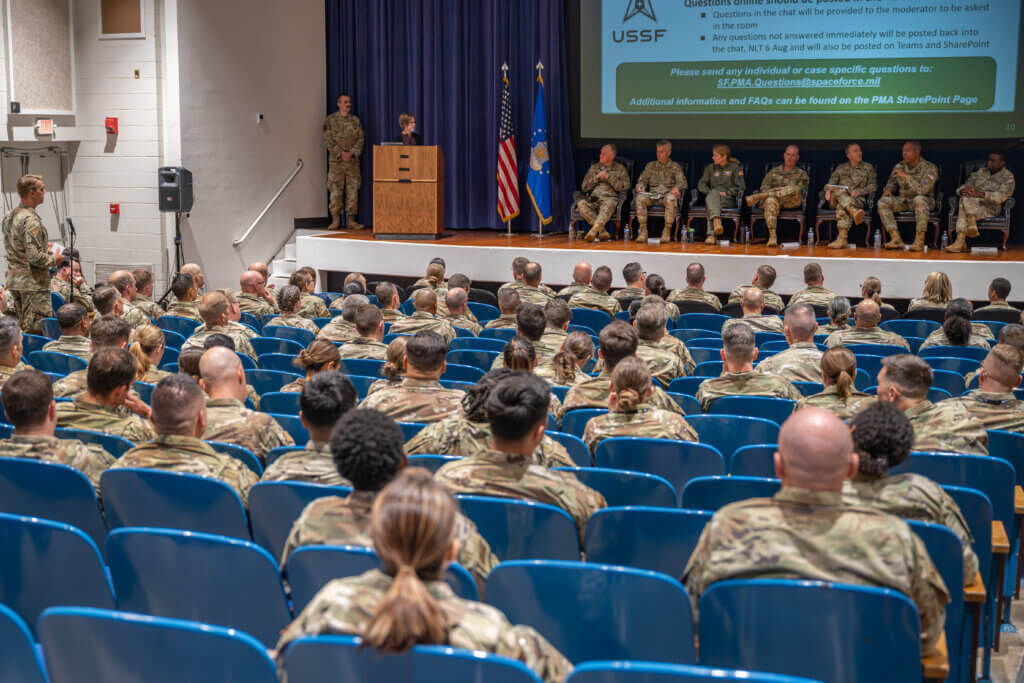The U.S. Space Force has closed out the second phase of its Personnel Management Act (PMA), or the provision that permits the transfer of Air Force Reserve Component Airmen, serving in space-focused career fields, to the new branch.
The PMA was established in 2023, with the full plan for the interservice transfer then being outlined in the National Defense Authorization Act (NDAA) for Fiscal Year 2025 (FY25). It is set to impact about 1,100 Air Force reservists over a multi-year phased plan.
The first phase, or Tranche 1, closed in June 2025, which offered airmen in the reserve component full-time positions in the Space Force. The application window for Tranche 2 closed on Oct. 10, when reservists could apply for part-time roles within the single component Space Force structure — or one without any reserve or Guard components.
Space Force Brig. Gen. Matthew Holston, PMA Integration director, said the PMA construct permits the branch to forgo the use of reserve component forces to fill steady-state, full-time requirements, and maximizes talent alignment to service needs in “non-sustained positions.” The positions fulfill a specific requirement and duty description in a Space Force unit, and are programmed at the minimum participation level — equivalent to 36 days per year.
“Space Force part-time positions differ from traditional Air Force Reserve positions in that all Guardians are managed under a single chain of command, integrated in the same units, and have the flexibility to move between full-time and part-time positions through the Guardian assignment process,” he said.
Air Force reservists who hold certain specialty codes like 1C6X1 Space Systems Operations Specialist, 1N031 Operations Intelligence, and 1N1X1 Geospatial Intelligence Specialists are all eligible for the transfer. Air Force commissioned officers with Core IDs in space, cyber and intelligence operations are also eligible. A release from the service stated the Air Force will no longer maintain space operations as career fields, meaning reservists who hold space-focused specialty codes must transfer to the Space Force or retrain if they want to stay in the Air Force.
Other than space experience, a selection board reviews applications for a service member’s readiness and quality. For senior-graded applicants, the board considers a member’s entire record to ensure they have the experience and skill set to meet senior-leader Space Force requirements.
Master Sgt. Tyler Alexander Odenweller and Lt. Col. David Fortson made the transition from Air Force reserve to full-time Space Force during Tranche 1. Both occupied space-specialty career fields and opted to apply for an interservice transfer. After 17 years in the Air Force, Fortson made the move from the 310th Space Wing — the last Air Force unit standing dedicated to space operations — at Schriever Space Force Base, Colorado, to the Pentagon.
“I was a bit hesitant because I love the Air Force — it was all I had ever known,” said Fortson. “But I saw the writing on the wall — if I wanted to stay in space, I would need to join the U.S. Space Force. Most of my career has been in space acquisitions or operations, and I couldn’t see myself doing anything else.”
Fortson was full-time Active-Guard Reserve in his former role as the 19th Space Operations Squadron director of operations. Now, he said he feels like his new role as an Acquisitions Intelligence integrator will benefit his career as he works at the enterprise level and considers the mission from a “bigger-picture perspective.” Odenweller also considers his transition from 428th Electromagnetic Warfare Flight to Headquarters Space Command (HQ SpOC), both located at Peterson Space Force Base, Colorado, a good career move.
“I’ve moved into a role at the field command overseeing the entire Service Tactics Development Program,” Odenweller said. “When I discussed the transfer with the Space Force team, I asked for a challenge, and I certainly got one. This experience has expanded the way I view problems and how I approach and present solutions.”
Service members selected for transfer during Tranche 1 are expected to receive orders by the end of this year. Tranche 2 applicants can expect to be notified of selection results by Spring 2026, followed by an assignment notification. Once complete, Space Force leaders said they expect the new PMA construct will allow them to manage their personnel more effectively, improve quality of life and retention, and capitalize on skill sets developed outside the military to continue delivering unmatched space capabilities.
“The Space Force is excited to build and manage our force using novel personnel management authorities to defend our nation’s vital interests in space,” said Holston. “PMA enables us to deliberately place the right Guardian, with the right talents, in the right position, at the right time to ensure we achieve space superiority and protect the joint force, our allies, and our partners.”

